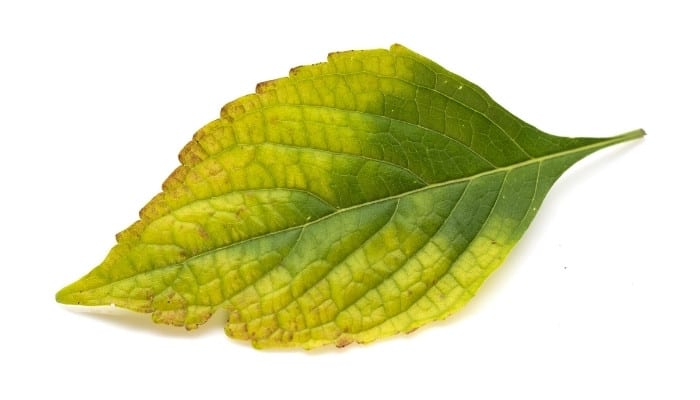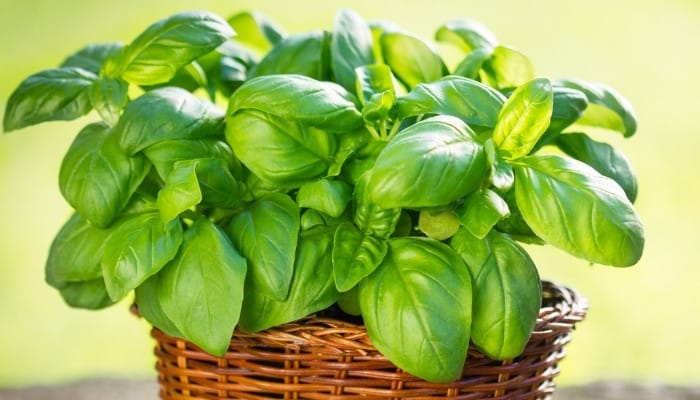Basil is known as one of the most adaptable herbs in the culinary realm, also referred to as Ocimum basilicum.
If you are a culinary wizard in the kitchen, then you probably have little pots of this herb growing on your kitchen window sill already.
This herb belongs to the mint family, or Lamiaceae family, and originates from the land of spice and flavor, India.
Pick a sunny spot in the garden or on a cozy window sill indoors, use well-draining soil, and provide plenty of water to keep your basil tasty and aromatic.
Why are my basil’s leaves turning yellow? Yellow leaves on a basil plant could indicate several issues ranging from the plant being dehydrated or overwatered to cold temperature conditions or insufficient lighting. In addition, fungal diseases, soil pH, and incorrect fertilization can also be contributing factors to yellowing leaves.
As a keen gardener and/or chef, you will want to understand why your usually vibrantly flavored basil has suddenly developed yellow leaves.
Use this concise and comprehensive guide to answer all your questions and encourage your basil plant to produce tasty green leaves.
Reasons Basil Plants Develop Yellow Leaves

When your basil plant develops yellow leaves, it may leave you scratching your head as to what could be the cause.
It’s usually best to follow a process of elimination, crossing each possible reason off the list.
Thankfully the list isn’t too long, and you are sure to have your basil back to its healthy self again.
Possible Cause #1 – Nutrient Deficiency
Aside from yellowing leaves, you may have noticed that your basil plant’s growth has slowed down as well.
The basil plant has a fast growth rate and needs an amazing amount of nutrients to support its vigorous growth speed.
Unfortunately, poor soils conditions significantly increase the risk of nutrient deficiency, and while the basil plant can grow in soils with low nutrient content, these conditions can result in yellowing foliage.
Generally, basil plants need an increased intake of nitrogen nutritional supplements to prevent nutrient deficiency and yellow leaves.
However, if the yellowing is centered around the leaf veins, then additional potassium will be needed.
Solution
Check that your basil plant does not require repotting. Old soil will have very little nutrient content, and the plant may have become rootbound.
Nutrient uptake for a rootbound plant is extremely difficult, resulting in insufficient feeding even if fertilizer is added to the soil.
If repotting is required, you should use a light nutrient-rich potting mix that drains well.
The soil should retain moisture but not become waterlogged. Basil plants enjoy a healthy amount of food and should be fertilized every four to six weeks if kept indoors.
Outdoor basil plants require fertilizing every two to three weeks.
You can use a water-soluble fertilizer diluted to 50% strength, or add compost, shellfish, or vermicompost to increase the nutrient content of the soil with nitrogen and essential growth minerals.
Possible Cause #2 – Overwatering
Overwatering is rated as the number one cause of yellowing leaves on basil plants.
While basil plants enjoy regular showering to promote and maintain healthy growth, too much water can spell disaster.
Excessive watering leads to suffocation of the roots, much like not being allowed up for air while swimming.
Overwatering can also wash the soil off the roots preventing them from spreading naturally.
Solution
While the most common cause of overwatering is the apparent addition of too much water, this can be compounded by two things.
First, poor container drainage and waterlogged soil go hand in hand.
Check the pot has sufficient drainage holes allowing for all excess water to drain between waterings.
Basil plants prefer moist soils that drain easily, so it’s best to avoid soils that can become clayey and compacted.
Possible Cause #3 – Bacterial Disease
Bacterial diseases are less common in the basil plant; however, a few can damage the basil plant’s healthy growth.
Bacterial leaf spot or basil shoot blight is caused by a bacteria called Pseudomonas cichorii. This bacteria is found in wet soil and areas of high humidity.
Plants are infected when infected soil splashes onto the leaves during watering sessions.
Solution
There are no easy solutions or quick fixes to rid your basil plant of bacterial leaf spot. However, there are ways to reduce the risk of bacterial disease.
Remove and dispose of infected plants to prevent the disease from spreading. Avoid overhead showering when watering to prevent splashing the leaves with soil.
Lower humidity levels by spacing plants appropriately, which will improve airflow around the plants.
Possible Cause #4 – Fungal Disease
Fungal diseases are often caused by warm, wet, and humid conditions – the perfect environment in which pathogens multiply.
Some examples of fungal infections that affect the basil plant are basil downy mildew, caused by the pathogen Peronospora belbahrii, and powdery mildew, caused by Podosphaera xanthii.
Symptoms of these diseases are yellow leaves and fluffy gray spores that grow underneath the leaves.
Fusarium wilt is a fungal disease that often affects sweet basil plants.
Symptoms include wilted and yellowing leaves, stunted growth, and brown spots on the stems. The fungus can be found in the soil or seeds of infected plants and so is quickly spread.
Solution
To control and rid your basil plant of downy or powdery mildew, remove the infected plants to prevent spores from spreading to healthy plants.
Trim infected leaves from the plant and dispose of them safely.
Then, apply a fungicide containing neem oil, sulfur, copper or potassium. I’ve used this copper fungicide with good success.
Avoid using overhead irrigation or showering to allow leaves to remain dry. Instead, increase the space between plants to allow for increased air movement.
There is no cure for Fusarium wilt, and due to the ease with which it spreads, it is best to destroy the infected plants immediately.
Avoid planting basil or mint plants in the infected soil area for three years as soil can carry the disease and spread the infection to other plants.
Possible Cause #5 – Pests
Aphids, caterpillars and root-knot nematodes are all pests that love the basil plant’s tender leaves, stems, and roots.
Aphids and caterpillars suck and feed on the leaves causing damage to the foliage and yellowing leaves.
Root-knot nematodes are parasitic, microscopic worms that live in the soil and live on the roots of plants.
They cause extensive damage to growth. Symptoms include yellow leaves and little balls growing on the roots.
Solution
Aphid infestations can be controlled using insecticidal soaps, and caterpillars can either be picked off or controlled with a natural bacterium such as Bt (Bacillus thuringiensis).
You can find Bt here – perfect for organic gardening.
Unfortunately, root-knot nematodes are challenging to get rid of once they have taken over the soil. The best solution is to uproot the plant and harvest healthy leaves.
Some cultivators opt to solarize the ground and thus destroy the worms, followed by leaving the soil fallow for a year to prevent the remaining worms from laying their eggs.
Possible Cause #6 – Natural Leaf Aging
The basil plant is an annual plant, meaning that its life cycle is usually completed in a single year.
(You can read all about basil’s life cycle and ideal growing conditions in our article here.)
If your basil plant has produced flowers and perhaps gone to seed, then it is officially time to wave a fond farewell to the plant.
(There are ways to prolong basil leaf production – learn how here.)
Older basil plants that have yellow leaves are an indication of age rather than pest or disease.
Solution
By removing the buds and flowers, you may be able to encourage your basil plant to last far longer.
Possible Cause #7 – Poor Growing Conditions
Poor growing conditions can also affect your tender basil plant’s leaves and cause them to turn yellow.
Chilly temperatures below 70℉ (21℃) and lack of sunlight can cause the basil plant to indicate its distress by developing yellow leaves.
Soils that are void of essential nutrients or have incorrect pH levels can also affect the plant’s growth resulting in yellowing foliage.
Solution
Trim the yellowing foliage as this will not return its vibrant green color.
Select a warm, sunny position with access to lots of bright sunlight, ensuring that temperatures remain between 70-50℉ (10-21℃).
Basil plants enjoy acidic soils with a pH level of between 6.0-6.5. Water frequently, but check that the soil is draining well between soakings to prevent overwatering.
Basil Leaf Common Questions

As a plant parent, you are bound to have many questions regarding your plants and their well-being, and basil plant parents are no exception.
We all enjoy seeing our plants thriving. Take a peek at some common questions people ask about the basil plant.
Should I Remove Yellow Leaves From Basil Plant?
Yes. Removal of yellowing leaves will prevent the plant from using all its energy feeding unproductive foliage.
Why Are My Basil Leaves Turning Yellow and Curling?
Yellow curling leaves can be a sign of overwatering or underwatering. Too much water or too little water will both have the same effect; the plant will die.
Fungal diseases, such as basil downy mildew, can also cause curling leaves.
Is It Safe To Eat Yellow Basil?
Yellow leaves signify the plant is suffering from either disease or is in distress from factors relating to its immediate environment.
It’s not a pleasant experience eating yellow leaves that are diseased or old as they can be bitter tasting; however, they are nontoxic and cannot make you ill.
Why Are My Basil Leaves Limp?
Overwatering or underwatering can cause leaves to droop, as can chilly temperatures and insufficient lighting.
Avoid the issue of limp leaves by keeping the soil moist but not soggy and providing lots of bright sunlight.
Interested in growing basil with hydroponics? It’s not as complex as you might think. Check out this article to learn the basics.
Related Questions:
How Do I Know If My Basil Is Overwatered?
Check the container to ensure the soil has not become waterlogged. Overwatering causes the lower leaves of the basil plant to start turning yellow.
The leaves will then begin to droop, and the soil will be soggy to the touch. Check that the roots have not turned brown and mushy, as this is an indication of root rot.
How Do You Know If Basil Has Root Rot?
Root rot is the result of overwatering the basil plant. Symptoms include foliage that yellows and then turns brown as the fungi grow in the plant’s roots.
The roots will appear soft and squishy and often look dark brown or black.
Advanced cases of root rot will see the plant start to drop leaves, followed by softening plant stems and eventual plant death.
Conclusion
This excellent herb is suitable to grow in your garden or on the kitchen windowsill. It can be used in many recipes and is used in medicines for stomach ailments.
Interestingly it is considered a sacred herb in Hindu culture, while other cultures see it as a sign of love and devotion.
By following the clear care instructions in this guide, you are sure to have a vibrantly tasty and health-benefiting basil plant.

